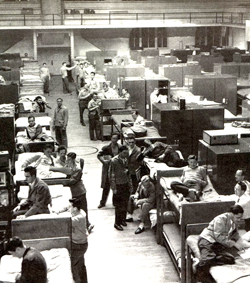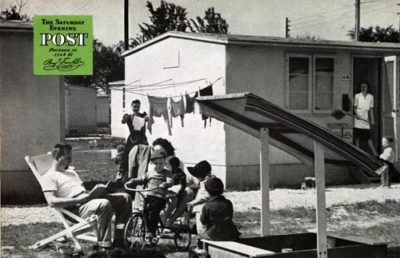A Hasty Prediction For the G.I. Bill
Its official name, when passed by Congress in June of 1944, was the Serviceman’s Readjustment Act, but it was soon renamed “the G.I. Bill of Rights.” While it provided several benefits to the veterans returning from World War II, the best remembered was the Reserve Education Assistance Program. Stanley Frank described the benefit in an August 18 issue of the Post:
Any man who has served in the armed forces for ninety days can attend for a year any approved school or college, and if he was less than twenty-five years of age at induction he is entitled to these benefits for a period equal to his military service after September 16, 1940, for a maximum of four years. The Government pays all bills for tuition and fees up to $500 a year.
It is a splendid bill, a wonderful bill, with only one conspicuous drawback. The guys aren’t buying it. They say “education” means “books,” any way you slice it, and that’s for somebody else. [“The G.I.’s Reject Education,” Stanley Frank, August 18, 1945]
He was right—partially, and only briefly.
As of February 1, 1945, only 12,844 discharged veterans throughout the country, in a total of 1,500,000, were attending schools under the G. I. Bill. Less than 1 per cent.
Frank had interviewed G.I.s at two veterans hospitals and found them anxious to get home and back to work as quickly as possible. Only 10% showed interest in further education. Most of these soon dropped out of the program.
Boiling down the figures, about 2 per cent of the amputees and neurosurgical cases—those who need it most—indicate an intention of having a go at serious, brain-building learning.
United States Army statistics prove that though [public education] has been free it hasn’t been popular. Only 23.3 per cent of the troops finished high school, and 3.6 per cent are college graduates. The average American soldier left school in the tenth grade, but … there are 5,000,000 in the armed forces who failed to graduate from grammar school.
Frank suggested the problem wasn’t schools, but “unchanging human nature”—i.e., most men don’t want to plan very far ahead in life.

We are, perhaps expecting too much of the tired, bewildered, embittered soldier, disassociated as he has been from civilian life, in asking him to plan his career. In normal times, most people have modest ambitions and are content to drift with the tide, evading responsibility if they can.
Though the college-benefit program had been in effect for a short time, some Post editor already saw the education benefit as a giant waste of taxpayer’s money.
Yet, by early the next year, there were signs of a general shift in Americans’ attitude toward education. Civilian adults, like the returning veterans, wanted to make up for the opportunities they’d lost during the war, and the Depression before it. Early in 1946, the Post reported “facilities of the country’s adult-education program are creaking under the load as [Americans] enroll by the hundreds of thousands.”
If, citizens have reasoned, a university can help practicing physicians, engineers, and so on, keep up to date, why can’t it tackle things that have ordinary folks stopped in their tracks?
A Gallup poll last spring indicated that 34 per cent of the adult population—25,000,000 folks—had the impulse to take advantage of part-time educational facilities after the war. [“Look Who’s Going To School Now!” Harold Titus, Feb. 9, 1946]
And just one year after the Post reported G.I.’s rejected education, it ran “Crisis at the Colleges.”

Heads of American colleges … are confronted with a reality that has always been a democratic dream: the opportunity to raise the educational attainments of a solid chunk of a whole generation. Because of the Government subsidy to servicemen, the opportunity is here; men who could never come to college under ordinary circumstances are enrolling or knocking at the doors.
[However] the colleges do not have the facilities, the housing, the instructors, or classrooms to handle [the opportunity]. The primary, the immediate, the all-important, problem is housing.
Thousands of eligible veterans were turned away last September because the colleges had no place to quarter them; thousands more were turned away in February at the beginning of the second semester. And yet the enrollment of veterans rose immensely because the colleges did find some place, some way, to house some of them.
Here was the situation at Illinois during the second half of the school year. Total undergraduate enrollment at Urbana … was 12,780. This is more students than ever attended there before. … Total veteran undergraduate enrollment was 5509.
There were veterans living in basements, veterans in garrets, veterans in made-over garages and abandoned filling stations. There were 300 sleeping in double-decker beds in the gaunt building known as the Old Gymnasium Annex.
Gone is the campus where every prospect pleases… Cruelest blows to academic serenity are the clotheslines behind the trailers and prefabricated houses. Along with the leaves of the traditional whispering maples there are, diapers and children’s underpants blowing in the wind.
By the time the program ended in 1956, it had helped 2.2 million Americans attend college and another 6.6 million receive training.
It would be hard to over-estimate the effect on this country made by this wave of America’s college-educated G.I.s. It enabled these men to lead the changing industries of the post-war world. It also produced a higher expectation for education in the American public; a 10th-grade education became less socially acceptable in the growing middle class.
The G.I.-Bill generation passed its faith in education on to the next generation, which passed on to their children. It is still an article of faith to many Americans today despite the low employment rate of college graduates.